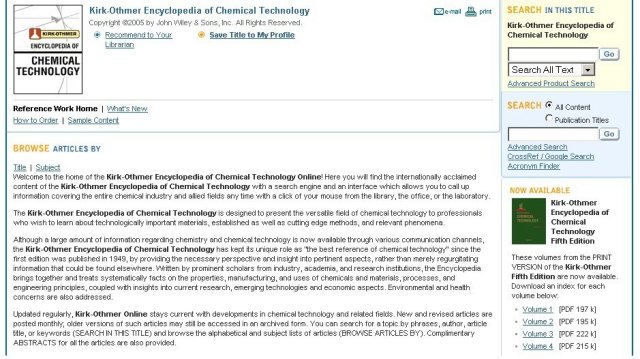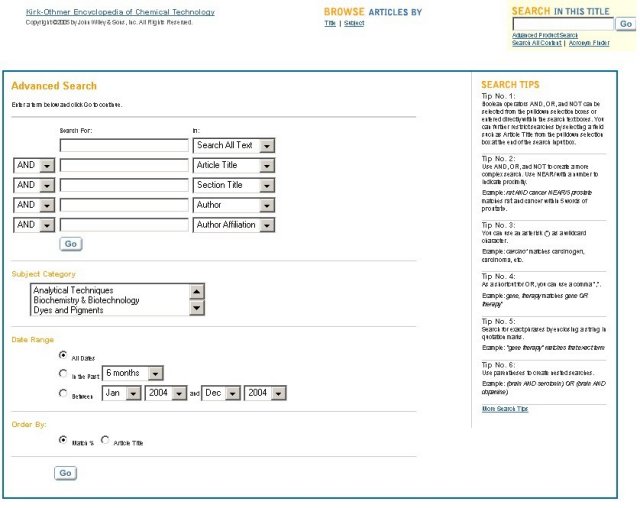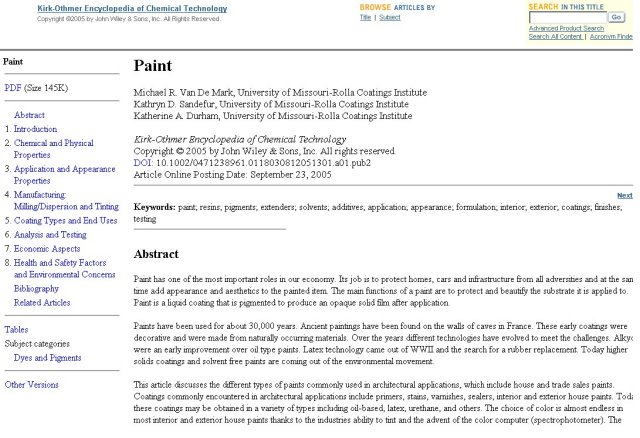| URLs in this document have been updated. Links enclosed in {curly brackets} have been changed. If a replacement link was located, the new URL was added and the link is active; if a new site could not be identified, the broken link was removed. |
Database Reviews
Kirk-Othmer Encyclopedia of Chemical Technology
and
Ullmann's Encyclopedia of Industrial Chemistry
Physical Sciences and Engineering Library
University of California, Davis
Davis, CA
cjcraig@ucdavis.edu
Introduction
The Kirk-Othmer Encyclopedia of Chemical Technology and Ullmann's Encyclopedia of Industrial Chemistry are long-established and essential titles in many science and technology libraries. Both encyclopedias offer a wide range of chemical and chemical engineering information; even frequent users are on occasion pleasantly surprised by the breadth and scope of these works.
Before reviewing the online versions of these titles, it will be useful to summarize the history and current status of the print editions. The first through fourth editions of the Kirk-Othmer Encyclopedia of Chemical Technology (Kirk-Othmer) were published in print between 1947 and 1998. The print version of the fifth edition began publication in 2004; the 26-volume set will be completed by early 2007 (Bayert 2006a). The first four print editions of Ullmann's Encyclopedia of Industrial Chemistry (Ullmann's) were published in German between 1914 and 1984. Publication in English began with the fifth edition (1985-1996). The most recent print edition of Ullmann's is the sixth edition consisting of 40 volumes published in 2003. Both encyclopedias were available online by 2000. Online editions are updated continuously and do not correspond to a given print edition (Bayert 2006a). Both the print and online versions are published by Wiley.
Kirk-Othmer has been called both the "most famous chemistry encyclopedia" and also the "single most valuable resource in a chemistry library's reference collection" (Wiggins 1991, pg. 276). Kirk-Othmer may have a greater following in English speaking countries because it has always been published in English. Both Kirk-Othmer and Ullmann's provide information on chemical substances and/or classes of compounds which generally include: physical and chemical properties and CAS numbers; manufacturing/production; toxicology and health/safety aspects; economic data and uses; handling, storage and regulatory information; and a substantial bibliography. In addition, both encyclopedias also offer extensive coverage of subjects fundamental to chemistry and chemical engineering, for example, catalysts, thermodynamics, analytical techniques, and process engineering (Bottle & Rowland 1992; Wolman 1988). See Figure 4 for a full list of subjects covered.
Although differences exist, Kirk-Othmer and Ullmann's are widely viewed as having similar coverage, but with Kirk-Othmer having a more North American perspective and Ullmann's having a more European/Japanese perspective (Maizell 1987; Maizell 1998; Matley 1986; Bayert 2006a). These encyclopedias can be viewed as complementary, since for any given topic, one title often contains some information the other does not (Maizell 1998; Bayert 2006a). For more in-depth discussion on coverage and emphases of these encyclopedias readers are referred to Maizell's excellent analysis of the print editions (Maizell 1998, pg. 252-263).
Some interesting statistics for both online encyclopedias are presented in Figure 1, data are from Bayert (2006a) and Ullmann's Encyclopedia of Industrial Chemistry Home Page. The home page for each encyclopedia is given below, and will provide additional information:
- Kirk-Othmer: {http://onlinelibrary.wiley.com/book/10.1002/0471238961}
- Ullmann's: http://www.mrw.interscience.wiley.com/ueic
| Online Editions | ||
|---|---|---|
| Kirk-Othmer | Ullmann's | |
| Number of Articles (approx.) | 1,250 | nearly 1,000 |
| Number of Tables (approx.) | 6,500 | 15,000 |
| Number of Figures (approx.) | 10,000 | 25,000 |
| Average Length of Articles | 25 - 35 pages | 30 - 50 pages |
| Updates | Monthly updates add 120 - 150 new or updated articles per year | Monthly updates add approx. 120 new or updated article per year |
| Subscribing North American colleges/universities | 61 | 35 |
| Number of Searches in January 2006 | 3,512 | 1,981 |
Search Interfaces
Both Kirk-Othmer and Ullmann's (and most other Wiley online reference works), utilize the same Basic and Advanced Search interfaces. The figures shown below are from Kirk-Othmer, however the comments apply to both Kirk-Othmer and Ullmann's, except where noted.
Basic Search
The Basic Search consists of a single search box included in on the home page for each encyclopedia. Figure 2 shows the combined Basic Search and Home Page for Kirk-Othmer, the Basic Search box is in the upper right margin under "Search In This Title." Using a drop-down box, searches can be limited to one of the following fields: All Text, Article Title, Section Title, Author, DOI, Table, Figures, or CAS Registry Number. If no field is selected the default is to search All Text. An "Advanced Product Search" link under the Basic Search box takes users to the Advanced Search screen (discussed below). A browse search by either article title or subject is available from both the Advanced and Basic search screens.

Figure 2: Basic Search/Home Page for Kirk-Othmer
The Basic Search/Home Page includes a second search box with options to Search "All Content" or "Publication Titles." Terms entered in this second search box (see Figure 2) will be searched against Wiley web pages, not in the encyclopedia. Because this has the potential to confuse some users (and more importantly because I prefer the more powerful search options on the Advanced Search page), at my institution we link directly to the Advanced Search page.
The Acronym Finder (available on both the Basic and Advanced Search pages) is a useful feature for science-related acronyms. Unlike many acronym finders it allows an exact match, beginning of term match, or wildcard match for acronyms. Searches can also be limited by academic discipline, and the list of acronyms can be browsed. The browse feature would be more useful if the Acronym Finder window could be made larger or maximized.
Within the Acronym Finder there is a link to 19 Reference Tables which provide easy access to often used scientific and technical acronyms, symbols, and abbreviations. Tables available include: Selected Chemical Symbols and Signs, Mathematical Symbols and Signs, Base Quantities and Units of the SI System, and Derived SI Units with Special Names and Symbols. A final link worth mentioning on the Basic Search page is What's New. This brings up a list of encyclopedia articles which have been recently added or newly updated.
Advanced Search
The Advanced Search screen (Figure 3) is well designed and provides a good balance between ease of use and very good search capabilities. The Advanced Search features five search boxes joined by Boolean operators. Search terms can be searched in All Text, or restricted to the following fields: Article Title, Section Title, Author, Author Affiliation, Keywords, DOI, Tables, Figures (only an option in the first search box), CAS Registry Number, Chemical Name, Trade Name, and Patent. Boolean operators can also be entered directly into the search boxes.

Figure 3: Advanced Search Screen
The Advanced Search page includes a pop-up box for subject categories (shown in Figure 3; see Figure 4 for a full list of subjects available). Searches can be restricted by combining a single subject category with search terms. A single subject category can also be selected, without entering search terms, to produce a list of articles available in that category. Searches can be limited by date (all dates; last 1, 3, 6, 9, or 12 months; or date range), and results may be ordered by article title or relevance. Once a subject term is selected, I have not found any way to deselect it other than to leave the search page and return. The addition of a "clear entries" button could alleviate this admittedly minor problem.
| SUBJECT CATEGORIES for Kirk-Othmer and Ullmann's | |
|---|---|
| Agrochemicals (Ullmann's only) | |
| Analytical Techniques | Materials |
| Biochemistry and Biotechnology | Metals and Alloys |
| Chemical Reactions | Organic Chemicals |
| Dyes and Pigments | Pharmaceuticals |
| Energy | Polymers and Plastics |
| Environmental Protection, Industrial Safety | Processes and Process Engineering |
| Fat, Oil, Food and Feed, Cosmetics | Renewable Resources |
| Inorganic Chemicals | Special Topics |
Within the search boxes (for both the Basic and Advanced Search screens) commonly used search practices are employed. Quotation marks (single or double) can be used to find exact phrases. Parentheses can be used to create nested searches. The truncation symbol (an asterisk) can be used for left, right, and inside the word truncation, and truncation works with a prefix or suffix as short as one letter (e.g., X* retrieves x-ray, xylylene, etc.; *X gets BTX Processing, etc.) Additionally, the comma can be used as a shortcut for the Boolean operator "OR."
Search Tips on the right side of the Advanced Search screen indicate proximity searching is possible, however, this feature does not work when searching Kirk-Othmer and Ullmann's. Proximity searching can be used to search Wiley web pages (via the "Search All Content" box shown in Figure 2, upper right). Wiley is aware of this problem and indicates it will be corrected with the next redesign of the site later this year (Bayert 2006b). The Advanced Search page (Figure 3) also includes a link to the Acronym Finder (discussed previously), and the Basic Search box is (upper right). In addition, the name of the encyclopedia (upper left) functions as a link to the Basic Search/Home Page.
Search Results
Search results display as a list of individual sections from encyclopedia articles. For each result the display includes: title of article, title of section, author(s), DOI, and relevance score. Two links are given: one leads to the section of the article where your search terms occur, the other takes you to the beginning of the article.
The display of individual articles is quite well thought out and allows easy movement both within the article and back to the search interface (see Figure 5). A persistent navigation bar on the left side of the screen contains links to: the PDF version of the article; individual sections of the article (including a bibliography and link to related articles); tables and figures (if included); subject categories assigned; and previous versions of the article (if applicable). The individual sections of the article are numbered and also serve as an outline. The PDF version of the article is a new feature added to both Kirk-Othmer and Ullmann's in October 2005. This is a tremendous improvement and makes printing of articles, e-mailing results, and searching for specific text within an article much easier. Including links to previous versions of articles is another commendable feature of these online reference works.

Figure 5: Article Display
The article abstract appears in the body of the page, also displayed are: article title and author(s), title of encyclopedia and abbreviated citation information, DOI, online posting date for the article, and keywords assigned. The top of the page provides links back to the Basic and Advanced search screens, as well as links to browse articles by title or subject, and the Basic Search box is available in the upper right.
References within the body of the article are linked to the full reference in the bibliography. Within the bibliography, references to online journal content (available via CrossRef) link directly to online articles. Links for companies and organizations are also given in the bibliography, these are spelled out as URLs and are also hyperlinked. When I began reviewing Kirk-Othmer and Ullmann's in January 2006, links to companies were not resolving correctly. However, these links now work correctly, and open a URL within the search results display.
A feature that Wiley might consider adding is a link or text indicating how encyclopedia articles should be cited. The simplest way to do this would be to provide generic text such as: How To Cite This Article: Author, A. "Title of Article." Kirk-Othmer Encyclopedia of Chemical Technology, etc. This would be extremely useful to both end users and librarians, and fairly easy to implement. An additional suggestion Wiley might consider for the future is to highlight search terms where they appear in the article display. This would make it easier to identify which articles or sections would be most useful. Linking directly to patents when they are listed in the bibliography might also be useful.
One note of caution regarding the "Article Online Posting Date" which appears in header information in the display of each article (see Figure 5). While this information serves a useful function, and should remain, it has the potential to mislead some users. For articles that have been updated or added since Kirk-Othmer and Ullmann's went online, the "Article Online Posting Date" corresponds to the date the article was written. However, articles that have not been revised or newly posted all seem to have the entry: "Article Online Posting Date: June 15, 2000." These articles likely have not been revised since they appeared in the last print edition before Kirk-Othmer and Ullmann's went online. (For Kirk-Othmer this was the fourth edition published between 1991 and 1998; for Ullmann's this was the fifth edition of the print version, published between 1985 and 1996.) For example the "Mathematical Modeling" article in Ullmann's appears to be the same article that appears in the fifth edition of the print version of Ullmann's, with very slight variations in pagination, table of contents, and table/chart placement. (Both the current online article and the article in the fifth edition of the print are the same length, have the same number of sections and references, paragraphs start the same, and neither article contains any references after 1990.)
Granted, a similar problem also exists with print titles when they are published in multiple volumes over several years, and librarians, publishers, and scholars are aware of this. However, in the online environment, the presence of the "Article Online Posting Date" for each article may cause some end users to assume articles are more recent that they actually are. As more online articles are updated, this issue will of course diminish.
Technical Issues
Online access to Kirk-Othmer and Ullmann's is available through either an annual subscription, or one-time purchase. Authentication is by IP address. The one-time purchase option provides access to the active version of the encyclopedia (at time of purchase), and includes all material added within 12 months of purchase. Institutions that select the one-time purchase option also have the option of purchasing Annual Updates. A minor point: librarians at institutions that do not purchase the Annual Updates should be aware that the error message which appears if you attempt to access an article not included with your one-time purchase, is the same one that appears if you lose access to the entire database. This can lead to some confusion, although this should only rarely be an issue.
The annual subscription provides access to the active version of the encyclopedia, in addition to any content added or updated during the subscription period. A subscription must be maintained in order to retain access to any content. A pay-per-view option is also available. More information on access and pricing is available via the "How To Order" link on each encyclopedia's home page (URLs given in Introduction section). Even without setting up a trial subscription, non-subscribers can use the basic and advanced search interfaces to generate results; and also access the list of article titles, abstracts, and subject categories. Some sample articles are also available, use the "Sample Content" links from each encyclopedia's home page.
Counter-compliant usage statistics are available via username and password on the Wiley web site. Vendor support for my institution has generally been quite good. We had some infrequent but recurrent loss of access problems for a period, but those have been resolved. Online help and technical support are available through a link in the upper right. On the few occasions when I have used the e-mail technical support feature, I have received a response within one or two working days (however, you must register with Wiley to use e-mail help). Online Frequently Asked Questions, and real-time chat are also available.
Final Thoughts
The Kirk-Othmer Encyclopedia of Chemical Technology and Ullmann's Encyclopedia of Industrial Chemistry are excellent sources for chemistry and chemical engineering information, and are the most widely used specialist encyclopedias in my library. The online search interfaces are well-designed and easy to use. With the addition of article in PDF format, search results are easy to manage. Kirk-Othmer and Ullmann's reputation as indispensable reference works is well-deserved.
References
Bayert, A. 2006a. "Re: Questions on Kirk-Othmer and Ullmann's for Article." E-mail to Cory Craig [cjcraig@ucdavis.edu]. Mar. 7, 2006.Bayert, A. 2006b. "Re: 2 More KO-UL Questions." E-mail to Cory Craig [cjcraig@ucdavis.edu]. Mar. 24, 2006.
Bottle, R. T. and Rowland, J. F. B. 1992. Information Sources in Chemistry, 4th edition. London, Bowker-Saur.
Chadwick, S. S. 1988. Ullmann's Encyclopedia of Industrial Chemistry [review]. Reference Services Review 16(4): 31-34.
Kirk-Othmer Encyclopedia of Chemical Technology Home Page. n.d. [Online]. Available: {http://onlinelibrary.wiley.com/book/10.1002/0471238961} [Accessed: April 14, 2006].
Matley, J. 1986. Ullmann's Encyclopedia of Industrial Chemistry [review]. Chemical Engineering 93(8): 95-98.
Maizell, R. E. 1987. How to Find Chemical Information: A Guide for Practicing Chemists, Educators, and Students, 2nd edition. New York, Wiley.
Maizell, R. E. 1998. How to Find Chemical Information: A Guide for Practicing Chemists, Educators, and Students, 3rd edition. New York, Wiley.
Ullmann's Encyclopedia of Industrial Chemistry Home Page. [Online]. Available: http://www.mrw.interscience.wiley.com/ueic [Accessed: April 14, 2006].
Wiggins, G. 1991. Chemical Information Sources. New York, McGraw-Hill.
Wolman, Y. 1988. Chemical Information: A Practical Guide to Utilization, 2nd edition. New York, Wiley.
| Previous | Contents | Next |
